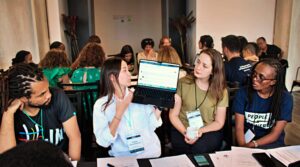Participatory Approaches in Digital Governance: Five Examples from the Field
Public participation is critical for building diverse voices into the governance of digital technologies, ensuring that they are trusted and governed in the interests of everyone. There are a multitude of participatory approaches being used in the complex field of digital governance—as displayed in the first of a series of learning webinars on democratic innovations hosted by People Powered, TAI Collaborative, and the Open Government PartnershipThe Open Government Partnership (OGP) is a multi-stakeholder initiative focused on improving government transparency, ensuring opportunities for citizen participation in public matters, and strengthen... More (OGP)—and each has the ability to improve the quality of digital legislationCreating and passing legislation is one of the most effective ways of ensuring open government reforms have long-lasting effects on government practices. Technical specifications: Act of creating or r... and debate.
Consider the following examples:
1) In Poland, where press reports are bringing digital governanceAs evolving technologies present new opportunities for governments and citizens to advance openness and accountability, OGP participating governments are working to create policies that deal with the ... More to the highest levels of government, the Fundacja Pole Dialogu is launching citizens’ juries to build a public debate on protecting children’s rights online. By gathering a group of experts, attentively designing agendas, and organizing meetings with the citizen juries, they will bring diverse voices, including those of youthRecognizing that investing in youth means investing in a better future, OGP participating governments are creating meaningful opportunities for youth to participate in government processes. Technical ... More, to the debate and aim to organize a national deliberative process with institutional support.
2) InclusionOGP participating governments are working to create governments that truly serve all people. Commitments in this area may address persons with disabilities, women and girls, lesbian, gay, bisexual, tr... More in digital projects reduces historical inequalities, shared Philip Thigo, Special Envoy on Technology for Kenya. Kenya is currently developing a Public ParticipationGiving citizens opportunities to provide input into government decision-making leads to more effective governance, improved public service delivery, and more equitable outcomes. Technical specificatio... Bill to safeguard human rightsAn essential part of open government includes protecting the sacred freedoms and rights of all citizens, including the most vulnerable groups, and holding those who violate human rights accountable. T... and fundamental freedoms online, as well as developing open channels for meaningful citizen engagement and feedback on digital services and policies. Trust cannot be digitalized without existing in the real world, and emphasizing collaboration in the digital regulationGovernment reformers are developing regulations that enshrine values of transparency, participation, and accountability in government practices. Technical specifications: Act of creating or reforming ... sphere fosters this healthy relationship between the public and government.
3) Similarly, the American University of Bulgaria launched a collaborative program around the use of AI in academic institutions, bringing experts and partner universities together to discuss AI’s benefits, threats, and opportunities. Students have been allowed to design the process and develop recommendations for the university’s AI use policy. This initiative is part of the People Powered mentorship program, which enables it to create innovative and effective practices on a university level, contributing to a shared knowledge base among participants on digital policy and participatory democracy.
4) Participatory design of AI strategies is also occurring on the governmental level in Uruguay, led by Uruguay’s Agency for e-Government. Through eight round tables with diverse stakeholders—academia, state level officials, entrepreneurs, and those from particularly affected industries like the creative fields—they are improving the existing AI strategy and building a new cybersecurity strategy. This builds off Uruguay’s longstanding five-stage participatory governance structure that includes problem diagnosis, public proposals, feasibility analysis, public consultations, and final draft approval with a monitoring and follow-up mechanism.
5) Creating opportunities for dialogue and collaboration between stakeholders helps to ensure that policies and reforms are fit-for-purpose. OGP’s multi-stakeholder approach to co-creating reforms is being increasingly applied to digital governance, making it one of the fastest growing topics in the Partnership. In the past two years, 40 percent of action plans have included a digital governance commitment and the Open Gov Challenge offers the opportunity to increase ambitionAccording to OGP’s Articles of Governance, OGP commitments should “stretch government practice beyond its current baseline with respect to key areas of open government.” Ambition captures the po... even further.
Public participation ensures that people affected by a decision are able to influence it, allowing for more responsive and effective governance and greater trust in decision-making. This is strongly needed in a policy area as complex and consequential as digital governance. These examples showcase that successful public participation can happen on any level—from improving a university ecosystem to working on a national AI strategy, or simply creating space for people to come together and design solutions that will work for them.
To learn more about the above examples and about public participation approaches as a whole, check out the webinar recording here.
Comments (1)
Leave a Reply
Related Content

Digital Governance: Automated Decision-Making, Algorithms, and Artificial Intelligence
 Challenges and Solutions
Challenges and Solutions
Three Pathways to More Meaningful Public Participation
To make public participation meaningful and inclusive, we need to synthesize knowledge, make it easier for reformers to connect with the right experts and use participation to solve big public…
 Uncategorized
Uncategorized
Want to take public participation online? We’ve got you covered.
People Powered has developed resources to help governments and civil society engage people online.


simon fenton-jones Reply
Thanks Tim,
That was an interesting stat.
“40 percent of action plans have included a digital governance commitment”.
If you investigate how digital (primarily world wide web) technologies have been included in individual National and Local government’s commitments then its around 95% since the OGP project started. So the wheel has been (attempted to be) invented a couple of hundred times. And that’s only in the perspective of one open government project.
If the UK is any indication, then there are around 800 other orgs and projects in each country with much the same percentages of duplicated approaches.
You’d understand that we have two parallel streams to opening government institutions. The first is government-to-government as the OGP project ( i.e. the OGP support team) attempts to do, and then individual governments attempting to use (internet) technologies in order to be inclusive of their civil communities.
I think the great pity is that policy makers only look at the “top layers of the internet”. They just don;t consider the problem as a “network engineering” problem. i.e. how do we include people in public network processes without creating problems for ALL citizens’ security and privacy.
Sooner or later we’ll get a focus on this new approach to an old problem.
Ive put up an overview to a session that does this. https://discuss.opengovernment.org.uk/t/open-government-partnership-steering-group-meeting-13th-december-2023/2672/5
Perhaps we can get a focus on the same page, at the same time, sometime.
In the meantime. Thanks for this
Simon 28/06/2024